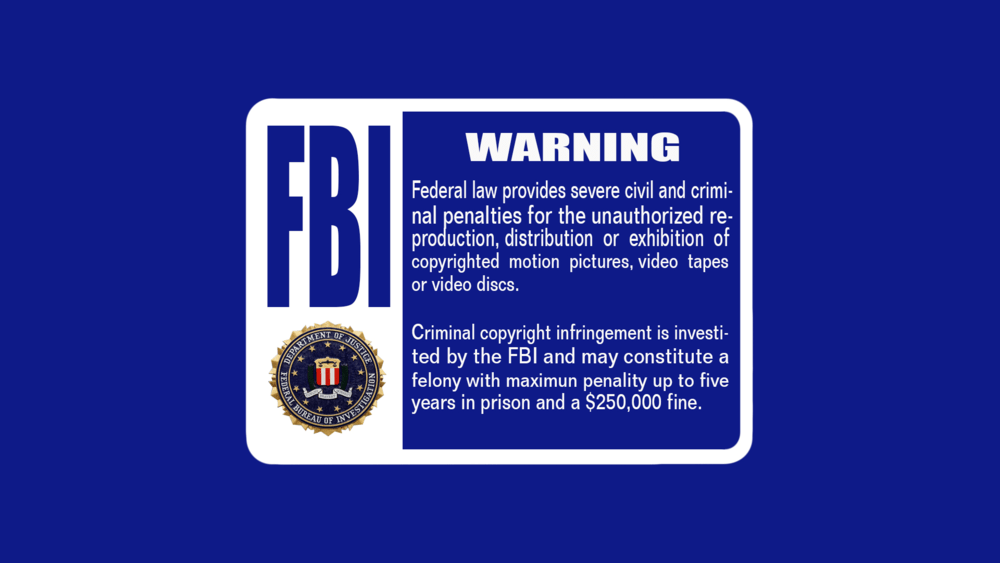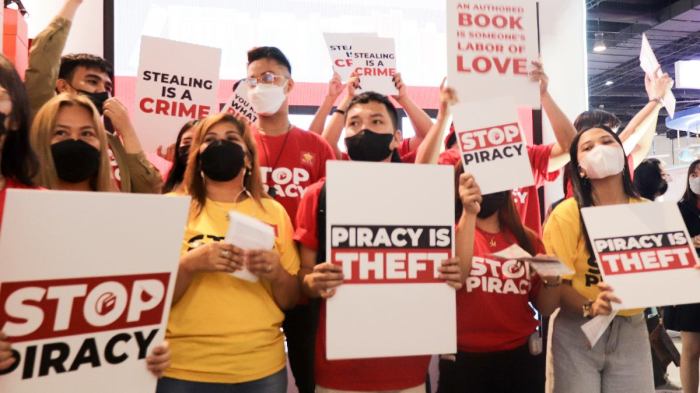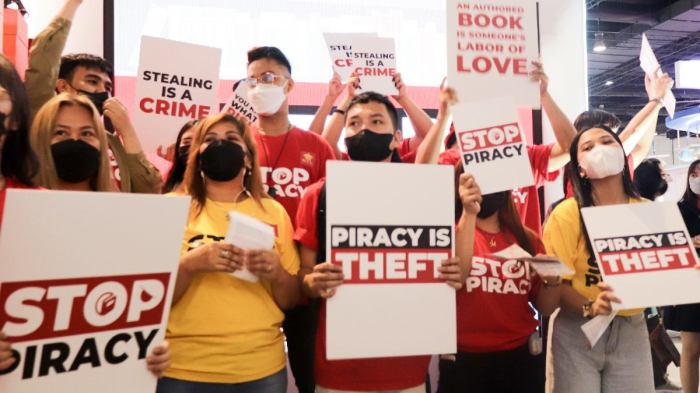Anti piracy campaign messages encourage piracy men – Anti-piracy campaign messages encourage piracy men, a paradox that begs examination. While aiming to deter illegal downloads, these campaigns sometimes inadvertently fuel the very behavior they seek to curb. This perplexing phenomenon invites us to delve into the complex psychology of piracy, explore the unintended consequences of anti-piracy messaging, and consider alternative approaches to protect intellectual property.
The irony lies in the potential for anti-piracy campaigns to backfire, particularly among male audiences. These campaigns often employ aggressive tactics, focusing on shame and punishment, which can trigger a rebellious response in some men. This, coupled with the perception that piracy is a “male” activity, further complicates the issue.
Understanding the nuances of these campaigns is crucial to crafting effective solutions that address the root causes of piracy without inadvertently fueling it.
The Paradox of Anti-Piracy Campaigns
The irony of anti-piracy campaigns is that they can sometimes inadvertently encourage the very behavior they aim to discourage. By making content difficult to access legally, or by creating a sense of persecution, anti-piracy measures can actually push some individuals towards piracy.
Potential Reasons for Increased Piracy
The effectiveness of anti-piracy campaigns hinges on understanding the motivations behind piracy. While some individuals may pirate content out of a lack of awareness about legal alternatives, others may be driven by factors such as:
- High Costs:In many cases, the cost of legally acquiring digital content can be a significant barrier. For example, a movie ticket can cost upwards of $15, while a streaming subscription can cost $10-$20 per month. For individuals with limited budgets, piracy can seem like a more affordable option.
- Lack of Availability:Not all content is readily available in all regions. This can be due to licensing restrictions, geographic limitations, or simply a lack of distribution. In these situations, piracy can be the only way for individuals to access desired content.
- User Experience:Strict anti-piracy measures, such as digital rights management (DRM), can create a frustrating user experience. DRM can limit the ways in which users can interact with their content, such as by preventing copying or sharing. This can lead to a sense of resentment and frustration, potentially encouraging piracy.
- Perception of Unfairness:Aggressive anti-piracy campaigns can sometimes be perceived as unfair or overly punitive. For example, lawsuits against individuals who have downloaded a single song or movie can be seen as disproportionate to the alleged offense. This can lead to a sense of injustice and resentment, which may further fuel piracy.
Targeting Male Demographics
Anti-piracy campaigns often target men, and there are several reasons for this. This focus is rooted in the perception of men as the primary consumers of pirated content, a stereotype that influences the strategies employed in these campaigns. It’s crucial to analyze the effectiveness of gender-specific messaging in anti-piracy campaigns and examine the underlying reasons behind this focus on men.
Stereotypes Associated with Men and Piracy
Common stereotypes associated with men and piracy contribute to the targeting of men in anti-piracy campaigns. These stereotypes, while often inaccurate, have influenced the perception of men as the primary perpetrators of piracy. The following points illustrate some of these common stereotypes:
- Men are seen as more technologically savvy than women, leading to the assumption that they are more likely to engage in piracy, which often involves downloading and sharing files online.
- Men are often portrayed as more interested in entertainment, particularly video games, movies, and music, which are frequently targeted by piracy.
- Men are stereotyped as being more rebellious and less concerned with legal consequences, which can be seen as contributing to their willingness to engage in piracy.
While these stereotypes may hold some truth, it’s important to acknowledge that they are generalizations and do not accurately reflect the diverse experiences of men. Furthermore, the rise of female gamers and content consumers challenges the assumption that piracy is solely a male-dominated activity.
The Psychology of Piracy

Piracy, the act of illegally copying and distributing copyrighted material, is a complex phenomenon driven by a confluence of factors, including access, cost, and convenience. Understanding the psychology behind piracy is crucial for developing effective anti-piracy campaigns and fostering a culture of respect for intellectual property.
Motivations Behind Piracy
Piracy is often fueled by a desire for access to content that might be unavailable or too expensive. This is particularly true in regions with limited access to legitimate streaming services or where the cost of purchasing content is prohibitively high.
The ease and convenience of accessing pirated content online, often with a few clicks, further incentivizes piracy.
Psychological Factors Driving Piracy
A range of psychological factors can contribute to individuals engaging in piracy. These include:
- Perceived Lack of Fairness:Some individuals may feel that the price of legitimate content is unfair, leading them to seek out cheaper alternatives. This sentiment can be particularly strong for those who feel that they are being overcharged for content they believe should be more accessible.
- Social Norms:Peer pressure and the perception that piracy is commonplace can influence individuals to engage in this behavior. If an individual’s social circle or online community condones piracy, they may be more likely to participate.
- Risk Perception:The perceived risk of being caught and punished for piracy can vary significantly. Individuals who believe that the likelihood of getting caught is low may be more likely to engage in piracy.
- Moral Disengagement:Some individuals may justify their piracy by rationalizing their actions. This can involve blaming the content creators for being greedy or believing that their actions do not harm anyone.
Motivations of Different Types of Pirates
While the motivations behind piracy can be complex, it is helpful to categorize pirates based on their primary driving force:
- Pirates for Personal Gain:This category includes individuals who pirate content for their own personal use, often driven by factors like cost, convenience, or access. They may not necessarily view their actions as morally wrong and may rationalize their behavior as a way to save money or access content they otherwise wouldn’t be able to afford.
- Pirates Out of Protest:This category includes individuals who engage in piracy as a form of protest against perceived injustices in the entertainment industry. They may be frustrated with high prices, restrictive licensing agreements, or perceived censorship. They may also believe that piracy is a way to reclaim control over their consumption of media.
Alternative Approaches to Piracy Prevention

The traditional approach to anti-piracy campaigns, often focused on fear and punishment, has proven to be largely ineffective. This is because it fails to address the underlying reasons why people choose to pirate content. A more effective approach requires understanding the motivations behind piracy and adopting a more nuanced strategy that focuses on addressing these underlying issues.
Obtain a comprehensive document about the application of grocery delivery app getir exits spain after adieu france that is effective.
Improving Accessibility to Legal Content
Instead of solely focusing on deterring piracy, a more effective approach is to make legal content more accessible and attractive to consumers. This involves addressing several key factors:
- Price:High prices for digital content can be a major deterrent for consumers, especially when cheaper or free alternatives are available. Lowering prices, offering subscription services, or introducing tiered pricing models can make legal content more appealing. For example, Spotify and Netflix have successfully adopted subscription models, offering access to vast libraries of music and movies at a fixed monthly price.
- Availability:Consumers should have easy access to the content they want, when they want it. This means offering a wide variety of content in multiple formats, including streaming, downloads, and physical copies. Additionally, ensuring compatibility with different devices and platforms is crucial.
For instance, Apple Music’s availability across various platforms and devices, including iOS, Android, and desktop computers, makes it more accessible to a wider audience.
- Convenience:The process of purchasing and accessing legal content should be straightforward and user-friendly. This includes simplifying the registration process, offering secure payment options, and providing clear instructions on how to download and play content. For example, Amazon Prime Video’s seamless integration with Amazon accounts and its intuitive user interface make it a convenient platform for accessing streaming content.
The Role of Technology in Piracy
The evolution of technology has undeniably played a pivotal role in the rise of piracy. From the early days of physical media to the digital age, technological advancements have both fueled and hindered the practice of copyright infringement. This section explores how technology has shaped the landscape of piracy, analyzing the impact of streaming services and file-sharing platforms.
The Impact of Technology on Piracy, Anti piracy campaign messages encourage piracy men
The advent of the internet and digital media has revolutionized how content is created, distributed, and consumed. This digital revolution has significantly impacted the rise of piracy. Here’s how:
- Ease of Access and Distribution:The internet has made it incredibly easy to access and share digital content, including movies, music, and software. Users can download and share files quickly and easily, often without any cost or legal repercussions. This ease of access has made piracy more accessible and attractive to a wider audience.
- Anonymity and Decentralization:Online platforms like peer-to-peer (P2P) file-sharing networks allow users to share files anonymously, making it difficult for copyright holders to identify and prosecute infringers. The decentralized nature of these platforms also makes it challenging to shut down piracy operations.
- Improved Quality and Accessibility:The advancement of technology has led to higher-quality digital content, making it more appealing for pirates to share. Streaming services have also contributed to the rise of piracy by providing convenient and accessible platforms for accessing content. This accessibility has made it easier for users to find and download pirated content.
Streaming Services and File-Sharing Platforms in Piracy
Streaming services and file-sharing platforms have played a complex role in the evolution of piracy. While they offer legitimate ways to access content, they have also been exploited by pirates to distribute copyrighted material illegally.
- Streaming Services:While legitimate streaming services offer a convenient and legal way to access content, they have also become a target for pirates. Piracy websites often use streaming services to host pirated content, allowing users to access it without paying. The availability of high-quality streams has made it easier for pirates to attract users and distribute pirated content.
- File-Sharing Platforms:File-sharing platforms, such as torrent sites, have been a cornerstone of online piracy for years. These platforms allow users to share large files, including movies, music, and software, without any central control. While some file-sharing platforms are legitimate, many are used to distribute pirated content.
Technological Approaches to Piracy Prevention
Technology can be a powerful tool for combating piracy, but it is not a silver bullet. Different technological approaches have their advantages and disadvantages:
| Approach | Advantages | Disadvantages |
|---|---|---|
| Digital Rights Management (DRM) |
|
|
| Content Identification and Filtering |
|
|
| Blockchain Technology |
|
|
Ethical Considerations in Anti-Piracy Campaigns: Anti Piracy Campaign Messages Encourage Piracy Men
The battle against piracy often involves complex ethical considerations, particularly when campaigns employ tactics that might be seen as intrusive, shaming, or even potentially infringing on user privacy. This raises crucial questions about the balance between protecting intellectual property and respecting individual rights.
The Ethical Implications of Shaming and Criminalization
Anti-piracy campaigns often utilize tactics that aim to deter users by portraying piracy as a morally wrong or even criminal act. While these campaigns may be effective in reducing piracy rates, they can also raise ethical concerns.
- Stigmatization and Social Exclusion: Campaigns that focus on shaming can lead to the stigmatization of individuals who engage in piracy, potentially isolating them from their peers and communities. This can have a negative impact on their social well-being and create a sense of guilt or shame that may not be proportionate to the act of piracy itself.
- Criminalization and Excessive Punishment: In some cases, anti-piracy campaigns can lead to the criminalization of activities that may be considered relatively minor, such as downloading a single song or movie. This can disproportionately affect individuals who may be unaware of the legal implications of their actions or who lack access to legal alternatives.
- The Paradox of Punishment: Research suggests that harsh punishments may not always be effective in deterring piracy. In some cases, they can actually backfire, leading to increased resentment and a greater likelihood of continued piracy.
Potential for Privacy Infringement
Anti-piracy campaigns can potentially infringe on user privacy in various ways:
- Data Collection and Monitoring: Some anti-piracy campaigns involve the collection of user data, such as IP addresses and browsing history, to identify potential pirates. This can raise concerns about privacy violations and the potential misuse of this information.
- Surveillance and Tracking: Anti-piracy efforts may involve the use of surveillance technologies to track user activities online, potentially leading to the monitoring of their online behavior and the creation of detailed profiles that could be used for other purposes.
- Sharing of Personal Information: In some cases, anti-piracy campaigns may involve the sharing of personal information with third parties, such as law enforcement agencies, without the consent of the individuals involved.
Ethical Guidelines for Anti-Piracy Campaigns
Developing ethical guidelines for anti-piracy campaigns is crucial to ensure that these efforts are conducted in a responsible and respectful manner. Here are some key considerations:
- Transparency and Disclosure: Anti-piracy campaigns should be transparent about their methods and objectives, clearly disclosing to users how their data is being collected and used.
- Respect for User Privacy: Campaigns should prioritize user privacy and avoid intrusive data collection practices. They should also ensure that user data is only used for legitimate anti-piracy purposes.
- Proportionality and Fairness: Anti-piracy campaigns should strive to ensure that punishments are proportionate to the offense and that individuals are not subjected to excessive or unfair penalties.
- Focus on Education and Alternatives: Campaigns should emphasize education and awareness about copyright law and provide users with access to legal and affordable alternatives to pirated content.


